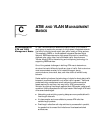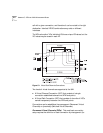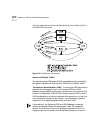
An Introduction to ATM and VLAN Management Basics C-9
emulated Ethernet service interface to higher level software which
implements the LAN Emulation User-to-Network Interface (LUNI).
LAN Emulation
Configuration Server
(LECS)
The LAN Emulation Configuration Server implements the assignment of
individual LAN Emulation Clients to different emulated LANs. When a LEC
initializes, it establishes connection to the LECS. Based on its own policies,
configuration database and information provided by clients, the LECS
assigns any client which requests configuration information to a
particular emulated LAN service by giving the client the LES’s ATM
address. This method supports the ability to assign a client to an
emulated LAN based on either the physical location (ATM address) or the
identity of a LAN destination which it is representing (ELAN name).
LAN Emulation
Server (LES)
The LAN Emulation Server implements the control coordination function
for the emulated LAN. The LAN Emulation Server provides a facility for
registering and resolving MAC addresses to ATM addresses. Clients may
register the LAN destinations they represent with the LAN Emulation
Server. A client will also query the LAN Emulation Server when the client
wishes to resolve a MAC address and/or route descriptors to an ATM
address in a process called LE Address Resolution Protocol (LE_ARP). The
LAN Emulation Server will either respond directly to the client or forward
the query to other clients and then forward the client response. In an SVC
environment, the LES responds directly to the LE_ARP to enable an LEC to
locate the BUS.
Broadcast and
Unknown Server
(BUS)
The Broadcast and Unknown Server handles the following:
■ Data sent by a LAN Emulation Client to the broadcast MAC address.
■ All multicast traffic.
■ Initial frames which are sent by a LAN Emulation Client before the
data direct virtual channel to the ATM address has been resolved.
All broadcast, multicast and unknown traffic to and from a LAN
Emulation Client passes through a single BUS.
The BUS also handles ATM connections and manages its distribution
group.
Virtual Channel
Connections (VCC)
Figure B-1 Communication among LAN Emulation Clients and between LAN
Emulation Clients and the LAN Emulation Service is performed over ATM Virtual
Channel Connections (VCCs). Each LAN Emulation Client must communicate
with the LAN Emulation Service over control and data VCCs. Emulated LANs


















